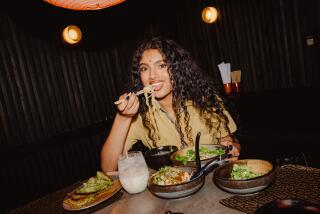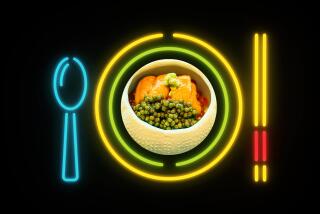Dining for Body and Spirit in India : Ordering <i> thali</i> is an intelligent way to experience a dazzling range of flavors--and to sample an ancient cuisine.
- Share via
MADRAS, India — If you’re invited to lunch--as I was--at a home in South India, you may wind up seated on the floor, eating from a banana leaf a collection of dishes that, served in a restaurant on a metal tray, would be called a thali. The food will be vegetarian, and the meal may be as much a religious ritual as a gustatory experience. South Indian vegetarian cookery is a high art that has developed over thousands of years. Its foods will dazzle you with their remarkable range of flavors.
Don’t be surprised if the men of the house are bare-chested, garbed from the waist down in a cloth wrapped like a sarong. That’s the way orthodox Hindus of the Brahmin caste dress both to worship and to eat food that is designed to promote physical as well as spiritual well-being.
Although my Sunday lunch with the Madras relatives of a Los Angeles friend included almost 20 dishes and three beverages, the food was light and refined, and I didn’t feel stuffed.
We sat on the floor in two rows facing each other. My hosts were accustomed to sitting cross-legged, but I shifted awkwardly from one stiff position to another. At my left was the family temple: a tiny room filled with religious objects, photographs and figures, with mango leaves strung across the top of the doorway. Later, I would be allowed to watch evening prayers, which were accompanied by chanting, blasts on a conch shell and the rhythmic, high-pitched tones of a small brass bell.
The banana leaves on the floor before us held about half a dozen spoonfuls of various dishes arranged in a prescribed pattern. As we ate, the women of the household brought out hot dishes, rice and refills. The custom is to eat with the fingers of the right hand, mixing portions of food with rice--popping the bundle in the mouth with the thumb as a lever. Picking up wet mixtures with rice wasn’t easy, but I guess clumsiness is expected of a foreigner. At least my hosts graciously acted as if this were so.
The dishes had names such as rasam , sambar , kosumbari , menaskai and payasam. Rasam is a spicy-sweet pineapple-and-lentil broth, while sambar is a thicker combination of lentils and cauliflower seasoned with a complex blend of spices. Still more vegetables and fruit appeared as curries, salads, pickles and chutney. These included sweet and sour mangoes (called menaskai ); shredded carrot mixed with green lentils ( kosumbari ); a cucumber-carrot-tomato salad; cow peas (pea beans) sweetened with jaggery (a mellow, dark palm sugar); plain lentils; cilantro chutney, and tempura-like fritters of plantain, potato and green pepper. Alongside we ate crisp lentil wafers called papads , plain rice sprinkled with clarified butter (ghee) and tamarind-seasoned rice combined with lentils and vegetables.
There were three sweets: cashew brittle, a ball of milk fudge, and payasam , a soupy bowlful of vermicelli, milk and nuts seasoned with cardamom and saffron. Then came homemade yogurt that was as thick and soft as a pudding. Before the meal, we drank sweet, fresh coconut water. Plain water accompanied lunch and strong South Indian coffee followed, along with a taste of a new dessert the cooks were perfecting: cubes of homemade fresh cheese in custard sauce.
Before eating, my host Ramavittal sprinkled water around his banana leaf, sipped water from the palm of his hand and took six small bites of rice. He was praying, he told me, and feeding the god within. A few grains of rice placed alongside his leaf honored the god of death. Afterward, Ram prayed while again sipping water from his hand. Then he sprinkled water on a tiny mound of salt at the edge of the banana leaf. Salt is highly personal and symbolic, he said. Eat salt at a dinner hosted by someone and you are indebted to him. Dissolve the salt in water and you’re free of obligation. After doing this, you eat nothing more. The leaf and the food remaining on it are given to the neighborhood animals.
As a tourist, you might not get to eat in an Indian home. But you can have the same sort of meal in many cafes and hotels in Madras, as well as in other places around India, where the thali has been adapted to local cuisines and styles. What you will get is a round, stainless-steel tray filled with small steel bowls called katori , each of which contains a curry, yogurt or other dish. In South India, I was served rasam , sambar , rice and curries made with seasonal vegetables. Also served were pickles, chutney, a yogurt-vegetable relish and the sweet of the day, which often is payasam, milk fudge or some other confection. There will be papads to begin and also pooris (breads that look like puffy, deep-fried tortillas) or, perhaps, whole-wheat chapatis (another kind of bread that looks similar to grilled flour tortillas).
For a tourist, the thali is a godsend. It’s a way to order intelligently without knowing anything about the food and to sample an ancient cuisine in one shot. Best of all is the price. I’ve eaten good thalis for as little as 67 cents. A dollar is about average in modest cafes, although I admit some travelers aren’t willing to venture into places where they are not certain the food is safe. The price in local places includes refills that you don’t even have to request. A server walks about ladling on more rice and food.
One of the best places to have a thali in Madras is the Hotel Dasaprakash. There you get plenty of local atmosphere because Dasaprakash caters to Indian travelers. Before lunch, wander through the grounds and the breezy corridors that front the rooms. You’ll find an open-air library equipped with well-stocked bookshelves and comfortable chairs, play areas forchildren and a temple room much like that at my friend’s home. You might even see a bare-chested Brahmin at worship.
Dasaprakash has two restaurants that serve only thalis. One offers upscale thalis for slightly more than a dollar. The other has basic thalis for low-budget travelers. They cost about half as much.
A deluxe thali at Dasaprakash is a sophisticated affair that may include continental dishes and specialties from Gujarat, a western Indian state renowned for its vegetarian cuisine.
My thali began with a western cream of vegetable soup accompanied by deep-fried banana chips seasoned with chili powder and salt. Other dishes included rasam , a sambar variation known as kootu , yellow lentils, a vegetable medley in yogurt sauce, a vegetable cutlet, carrot salad, yogurt relish, lime pickle and chapatis. I also tasted Gujarati dishes, such as khadi , that showed the region’s passion for sugar, even with vegetables.
The thali style of eating developed centuries ago in Gujarat and the northern state of Rajasthan. Originally, families ate from one communal tray, which in wealthy homes was made of silver. This evolved into individual thalis made of cheaper metals.
Today, thalis are served all over India, and the food changes with the region. I paid 90 cents for a Punjabi vegetarian thali at Nirula’s, a snack shop in New Delhi. But low price did not mean a skimpy meal. Nirula’s dishes out sturdy fare such as potatoes mixed with channa dal (chickpeas), black lentils, white Indian cheese in a red curry sauce, ornate biryani rice, a savory yogurt-soaked bun made of lentil dough, a little salad called kachumbar , chapatis and crisp papads.
In Agra, I geared up for a tour of the Taj Mahal with a Shah Jahan thali , named for the mogul emperor who built the gorgeous tomb. I found that thali at SoNam, a delightful garden restaurant. The regal but inexpensive meal (about $3.30) included lentil soup, lamb kebabs, spicy ground meat, a mild lamb curry called rogan-e-gosht, pullao (mildly spiced) rice, chutney, salad and an eggy, custard dessert. I was especially taken with a bowl of bananas in pale-pink-tinted yogurt--a gentle dish fit for Mumtaz, the lovely queen entombed in the Taj.
Working my way south, I stopped for a few days at Secunderabad, the twin city of Hyderabad in the state of Andhra Pradesh. There I dined at an excellent vegetarian restaurant called Dawaat in the Hotel Baseraa, which is close to the railroad station, as well as to good shopping areas. A thali at Dawaat set me back only 75 cents. But I made up for that bargain by ordering sweet lime juice, which cost almost as much. The sweet lime is an Indian citrus fruit that tastes like an orange crossed with a delicate lime.
“Outrageously good,” I wrote in my traveler’s journal.
The thali bore the usual assortment of South Indian vegetable curries, pullao rice, yogurt, soupy lentils, breads and strong-tasting pickle. One dish, palak paneer-- got raves. It was a combination of freshly made cheese-- paneer --with spinach or mustard greens ( palak can be either one).
“Velvety texture and perfect balance of seasoning,” I wrote.
In the tropical south, banana leaves were free for the taking, so they became the region’s plates. At a South Indian wedding, hundreds of guests may dine off rows of leaves. Some restaurants use banana leaf place mats. Dakshin, a luxurious South Indian restaurant in the Park Sheraton Hotel & Towers in Madras, re-creates the traditional banana leaf meal in an updated, fancy way. The leaf, trimmed to a circle, sits inside a tray, and you spoon the food onto it from little serving bowls.
Dakshin is the Sanskrit word for “south,” and this restaurant specializes in food from the four southern states: Tamil Nadu, where Madras is located; Kerala; Karnataka and Andhra Pradesh. Dakshin also serves the famous South Indian coffee, poured in a yardlong stream from one container to another to make it frothy. And you can order all the components of a thali and eat them in ancient style from your thali -style banana leaf.
I had great dishes at Dakshin: tomato curries and cauliflower stir-fried with black pepper, a leading spice crop in the south, and strongly aromatic curry leaves, which are used only in South Indian cooking. Highly spiced, deep-fried colocasia (taro) slices might woo you away from potato chips. And lentils are prepared in a multitude of delicious ways. Just one example is keerai kootu : red lentils and spinach flavored with mustard seeds, cumin and a pinch of asafetida , a pungent spice that tastes like no other and is thought to aid digestion.
Dasaprakash serves only vegetarian food, but Dakshin offers seafood and meat, too, so you can embellish your thali with such southern specialties as fish in coconut curry, shrimp marinated with ginger, garlic and chile paste or chicken in black pepper gravy.
A vegetarian thali in a five-star hotel in India will cost as much as $10, plus tax, service and beverage, and a non-vegetarian thali will run slightly more. But imagine getting an elaborate meal of first-rate food in luxurious surroundings for that price in the United States.
GUIDEBOOK: Thali Time in India
Dakshin: Park Sheraton Hotel & Towers, TTK Road, Madras 600018, telephone locally 452-525.
Dawaat: Hotel Baseraa, 9-1-167/168, Sarojini Devi Road, Secunderabad 500003, tel. 823-200.
Hotel Dasaprakash: 100, Poonamallee High Road, Madras 600084, tel. 66l-111.
New Woodlands Hotel: 72-75, Dr. Radhakrishnan Road, Mylapore, Madras 600004, tel. 473-111 or 477-881.
Nirula’s snack shop: located just outside Nirula’s Hotel, L-Block, Connaught Circus, New Delhi 110001, tel. 332-2419.
SoNam: 51 Taj Road, Agra 282001, no phone number available.
More to Read
Eat your way across L.A.
Get our weekly Tasting Notes newsletter for reviews, news and more.
You may occasionally receive promotional content from the Los Angeles Times.










